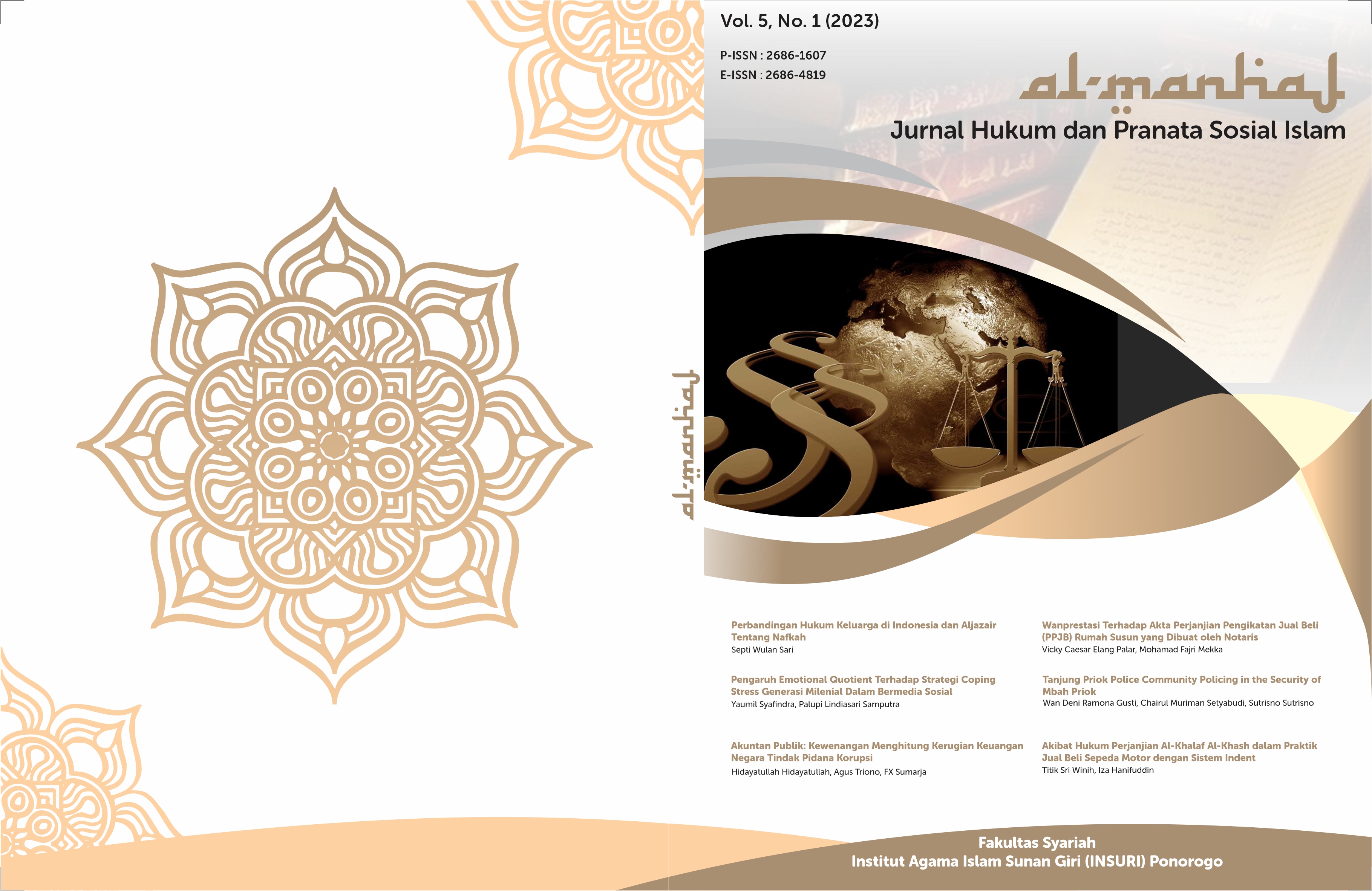Tinjauan Hukum Islam terhadap Ketentuan Penegakan Hukum Pemberantasan Korupsi di Indonesia
DOI:
https://doi.org/10.37680/almanhaj.v5i1.2369Keywords:
Islamic Law; Law; CorruptionAbstract
This study seeks to find solutions to the rampant corruption practices in Indonesia today. The purpose of this study is to further reason about the legal norms contained in the legislation related to law enforcement corruption eradication in Indonesia by using the approach of Islamic law theory. The research method used in this study is a normative juridical approach that is done by examining the theories, concepts, principles of law, legislation by putting the law as a building system of legal norms. the results of the study conducted that the legal norms contained in the legislation on the eradication of corruption contains only two elements, namely AR-Rashi and al-murtashi, on the contrary in Islamic law there are three elements of ar-Rashi, al-murtashi and ar-Ra'isy. If the element of ar-raisy (intermediary) is not absorbed into the sub-system of Corruption Eradication law, it will become very weak. the concept of punishment in the Corruption Eradication legislation is limited to imprisonment and fines, while in Islamic law it is divided into three categories, namely; First, the ta'zīr law which is about the body consisting of the death penalty and volumes; second, the ta'zīr punishment which is about the independence or freedom of a person in the form of imprisonment; and Third, ta'zīr law regarding property, such as punitive damages or fines and confiscation so that Islamic law looks more comprehensive and systematic.
References
Adnan Lutfi, M., Kurniaty, Y., Basri, B., & Krisnan, J. (2022). Studi Perbandingan Tentang Penetapan Sanksi Pidana Pencurian Berdasarkan Hukum Pidana Positif Indonesia dan Hukum Pidana Islam. Borobudur Law and Society Journal, 1(1), 20–30. https://doi.org/10.31603/6537
Aisyah, F. (2022). TAUBAT SEBAGAI PENGGUGUR HAD TERHADAP PELAKU TINDAK PIDANA PENCURIAN ( JARIMAH SIRQAH ) PERSPEKTIF IMAM AL-NAWAWI. JATISWARA, 37(1), 78–92.
Al-‘Amir, ’Abd Al-‘Aziz. (1976). Al-Ta’zir fi al-Syari’ah al-Islamiyyah. Dar al-Fikr al-‘Arabi.
Fazzan. (2015). KORUPSI DI INDONESIA DALAM PERSPEKTIF HUKUM PIDANA ISLAM. Jurnal Ilmiah Islam Futura, 14(2), 146–165.
Firmansyah, F. (2017). Korupsi Dalam Perspektif Filsafat Hukum Islam. Al-Amwal : Journal of Islamic Economic Law, 2(1), 36–50. https://doi.org/10.24256/alw.v2i1.599
Ginting, G. (2023). Kajian Hukum Penerapan Ketentuan Hukuman Mati dalam Undang- Undang Tindak Pidana Korupsi. AL_MANHAJ Jurnal Hukum Dan Pranata Sosial, 5(1), 519–526. https://doi.org/10.37680/almanhaj.v5i1.2442
Gunawan, H. (2018). Korupsi Dalam Perspektif Hukum Islam. Yurisprudentia, 4(2), 182–199. https://doi.org/10.21107/ete.v1i1.4591
Hamka, Nazaruddin, N. (n.d.). KONSEP QIYAS DALAM PENERAPAN POTONG TANGAN TERHADAP KORUPTOR.
Kementerian Hukum Dan Hak Azasi Manusia Republik Indonesia(n.d.). https://www.google.com/url?sa=i&rct=j&q=&esrc=s&source=web&cd=&cad=rja&uact=8&ved=0CAIQw7AJahcKEwjQ3ISB3fPUAAAAAHQAAAAAQBg&url=https%3A%2F%2Fditjenpp.kemenkumham.go.id%2Findex.php%3Foption%3Dcom_content%26view%3Darticle%26id%3D2002%3Ahukuman-mati-untuk. Media Publikasi Peraturan Perundang-Undangan Dan Informasi Hukum.
Ishak. (2015). Sanksi Pidana Perampokan dalam KUHP dan Hukum Pidana Islam. Ahkam, XV(2), 25. http://repository.uinjambi.ac.id/70/1/Sanksi Pidana Perampokan ....pdf
Khallaf, A. W. (2002). Sejarah Pembentukan dan Perkembangan Hukum Islam (II). Raja Grafindo Persada.
Maulida, A., Hafidhuddin, D., Syafri, U. A., & Tamam, A. M. (2020). Tindak Pidana Korupsi Dalam Perspektif Hukum Indonesia dan Pidana Islam. Al-Mashlahah: Jurnal Hukum Islam Dan Pranata Sosial Islam, 8(1), 43–67.
Mustakid, D. (2021). Tindak Pidana Korupsi dalam Persepektif Hukum Positif dan Hukum Islam. Jurnal Hukum Pidana Islam Jurnal Edu Law : Jurnal Of Islamic Law and Yurisprudance, 3(01), 15–25.
Rahmi, N. (2019). Hukuman Potong Tangan Perspektif Al-Qur`an Dan Hadis. Jurnal Ulunnuha, 7(2), 53–70. https://doi.org/10.15548/ju.v7i2.254
Ramadhan, H. A., Y, Y., & Aksa, F. N. (2021). Tindak Pidana Korupsi Dalam Persfektif Hukum Pidana Dan Hukum Pidana Islam. Jurnal Ilmiah Mahasiswa Fakultas Hukum Universitas Malikussaleh, IV(3), 21–29. https://doi.org/10.29103/jimfh.v4i2.4267
Sakinah. (2014). KORUPSI DALAM PERSPEKTIF HUKUM ISLAM. Et-Tijarie, 1(1), 62–73.
Sapri Ali. (2018). Tinjauan Hukuman Pidana Masyarakat Pinggiran dalam Perspektif Hukum Islam. El-Faqih : Jurnal Pemikiran Dan Hukum Islam, 4(2), 1–23. https://doi.org/10.29062/faqih.v4i2.4
Syah, I. M. (1992). Filsafat Hukum Islam. Bumi Aksara.
Downloads
Published
How to Cite
Issue
Section
License
Copyright:
- Author retains the copyright and grants the journal the right of first publication of the work simultaneously licensed under a Creative Commons Attribution 4.0 International License that allows others to share the work with an acknowledgment of the work's authorship and initial publication in this journal.
- Author is able to enter into separate, additional contractual arrangements for the non-exclusive distribution of the journal's published version of the work (e.g., post it to an institutional repository or publish it in a book) with the acknowledgment of its initial publication in this journal.
- Author is permitted and encouraged to post his/her work online (e.g., in institutional repositories or on their website) prior to and during the submission process, as it can lead to productive exchanges, as well as earlier and greater citation of the published work (See The Effect of Open Access).
License:
-
Attribution — You must give appropriate credit, provide a link to the license, and indicate if changes were made. You may do so in any reasonable manner, but not in any way that suggests the licensor endorses you or your use.
-
No additional restrictions — You may not apply legal terms or technological measures that legally restrict others from doing anything the license permits.
You are free to:
- Share — copy and redistribute the material in any medium or format
- Adapt — remix, transform, and build upon the material for any purpose, even commercially.

This work is licensed under a Creative Commons Attribution 4.0 International License.














